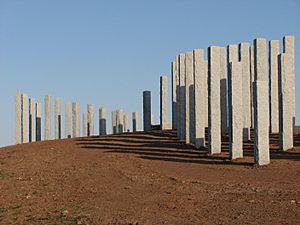Portland limestone facts for kids

Portland limestone is a special type of rock called limestone. It formed a very long time ago, during the late Upper Jurassic period. This was about 150 million years ago! It was first discovered on the Isle of Portland in Dorset, England. But you can find similar stone in many other places, even in France. This rock often looks white or grey and is found in layers.
Contents
How Portland Limestone Forms
Where Limestone Comes From
Portland limestone formed in a shallow, warm, sub-tropical sea. This sea was on the edge of what is now western Europe.
Most limestones are made of calcium carbonate. This material comes from the shells and skeletons of tiny sea creatures. For example, very small organisms called coccolithophores make their shells from calcium carbonate. These tiny creatures were important because they helped calcium carbonate fall to the bottom of the ocean.
On the shallow parts of the world's oceans, living things like coccoliths, bacteria, and algae create calcium carbonate. Many animals, such as bivalves (like clams) and coral reefs, also use it to build their shells or structures. Carbonate rocks are made from these sources, plus any calcium carbonate that forms from the water itself.
Florida Bay: A Modern Example
Florida Bay, a shallow area of water behind the Florida Keys, is a good example of how limestones form. The types of plants and animals living there today are different from those long ago. But the way the ecosystem works is very similar.
In Florida Bay, you can find lots of sea grass. The water is also milky white because it's full of calcium carbonate. This calcium carbonate mainly comes from a small red alga called Melobesia, which lives on the sea grass. These organisms also produce a lot of slime. Scientists think this slime helps tiny living things control how their carbonate skeletons are made.
Florida Bay is a flat area where a huge amount of carbonate rock has built up. If you drill down, you would have to go more than 3,000 feet before finding a different type of rock. That shows how much limestone can form over millions of years!
Changes Over Time
Carbonate rocks look different depending on where and when they formed. This is because different organisms lived there and created the carbonate. Also, things like underwater landslides and earthquakes could have disturbed the layers of rock. Sometimes, the making of carbonate stopped, and different organisms created silica, which we see as layers of chert.
In Portland limestone, much of the muddy material settled with small pieces of shells or sand. These pieces became covered with layers of lime mud. They formed tiny balls, less than half a millimeter wide, called "ooids" or "ooliths." Over time, billions of these ooids became partly stuck together by more calcite. This created the oolitic limestone we know as Portland limestone.
What Portland Stone is Used For
A Popular Building Stone
Portland stone has been widely used as a building material in the British Isles. It is quite expensive, but its qualities make it worth the cost.
You can see it in many famous public buildings. These include Buckingham Palace, St Paul's Cathedral, and the British Museum in London. It is also sent to many other countries. For example, Portland stone was used to build the United Nations headquarters in Manhattan, New York.
Portland stone is strong enough to last a long time against weathering (like rain and wind). But it is also soft enough for stonemasons to cut and carve it easily. This is why it is so good for important buildings and monuments.
Used in Cement
In 1824, a man named Joseph Aspdin invented a new type of cement. He made it by burning a mix of limestone and clay. The limestone he used was Portland limestone. Because of this, he patented the name Portland Cement. Builders quickly realized that this new cement was much better than older types, even though it cost more. Portland Cement is still widely used in construction today.
Images for kids
-
Portland stone quarry on the Isle of Portland, Dorset.
-
St Paul's Cathedral, London by Christopher Wren, built 1677.
-
100 King Street, Manchester by Edwin Lutyens, built 1935.
-
Port of Liverpool Building, Liverpool, built 1907.
-
United Nations Headquarters, New York City, built 1952.
See also
 In Spanish: Piedra de Pórtland para niños
In Spanish: Piedra de Pórtland para niños









